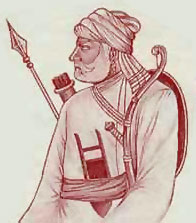|
Durga
Dass Rathore, the son of Askaran, was a hereditary
jagirdar under Maharaja Jaswant Singh I of Marwar. He
was present with the Maharaja at Jamrud when the died
there in harness. Durga Dass played key role in safely
escorting the family of his master from Jamrud to Marwar
via Delhi, the Mughal capital. He displayed loyalty to
his master by risking his own life in open conflict
against the Mughal soldiers when Jaswant Singh’s
posthumous son Ajeet Singh was being secretly carried
away from Delhi to Jaitaran in Marwar. He, along with
other fellow Sardars of Marwar, took care to remove
Ajeet Singh from Jaitaran to Kalindri in Sirohi. It was
at his initiative that Maharana Raj Singh of Marwar
agreed to provide shelter to Ajeet Singh in the battle
of Debari when combined force of |
 |
|
|
Merwar and
Marwar were defeated by the Mughals. He was note disappointed
by the annexation of Marwar to Mughal Empire followed by
anihililation of Rajputs in the battle of Debari. On the one
hand he continued to guide and inspire his clansmen to raise
revolts in different parts of Marwar to weaken the Mughal hold
over the newly acquired territories and on the other hand he
played the part of a diplomat by trying unsuccessfully to come
closer to Muazzam and then by instigating the third son of
Aurangzeb to revolt against his father. He succeeded in
getting recognition for Ajeet Singh as the real son of Jaswant
Singh from the rebel prince at a crucial time when Aurangzeb
was not prepared to recognize Ajeet Singh. Prince Akbar
conferred on Ajeet Singh the title of Maharaja and Mansab. His
foresightedness in escorting Akbar from Rajasthan to the
Deccan was a calculated move because Aurangzeb also left for
the Deccan to check the possibilities of Maratha – Rajput
alliance against him. The intensity of Mughal atrocities was
lessened with the movement of Aurangzeb from Rajasthan.
Moreover, opportunities were provided to various Rathor
Sardars to crate disturbances in Mughal territories to weaken
their hole. Despite being away from Marwar, Durga Dass was in
touch with his fellow nobles in these hard times when means of
communications were almost inadequate. Despite the fact that
Durga Dass was born and brought up in the traditional way, he
was different from the Ran Bankura Rathors of his age who
believed in displaying their personal velour and chivalry. He
possessed the qualities of a statesman. But for this Ajeet
Singh could not have got over financial stringency. Further,
despite differences with his Swami Ajeet Singh he rose to the
occasion to advise him not to fall in the Mughal trap when
Ajeet was invited at Ajmer in 1692 to meet Shujaat Khan.
Similarly, he was present in the battle of Sambhar. The Mughal
Emperor Jahandarshah conferred on his the title of ‘Rao’ and
awarded mansab of 4000 Zat and 3000 sawar.
The name of Durga Dass continues to figure
in the official records of the Mughal Empire till about the
year 1716 A.D. On many occasions Khilats were conferred on his
and his mansab was raised time and again. But in the
chronicles of Marwar his name is not mentioned after the
victory of Rajputs in the battle of Sambhar. There may be two
reasons for it. Firstly, his strained relations with Ajeet
Singh which were completely ruptured by 1702. Secondly, the
jealousy of his fellow clansmen because of his unique position
in Marwar and Mughal Empire. Still, the tales of his heroic
feats, devotion and sacrifice is remembered not only by the
people of Marwar but by every Indian. His narrative presents
an uninterrupted record of patriotism and loyalty. |